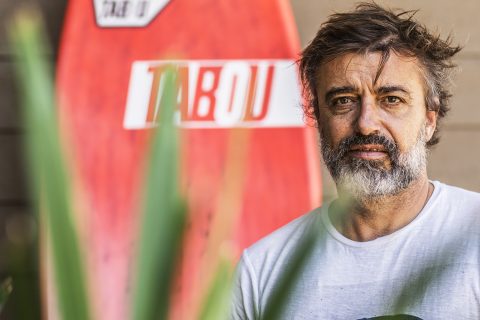FABIEN SHAPES: FABIEN VOLLENWEIDER
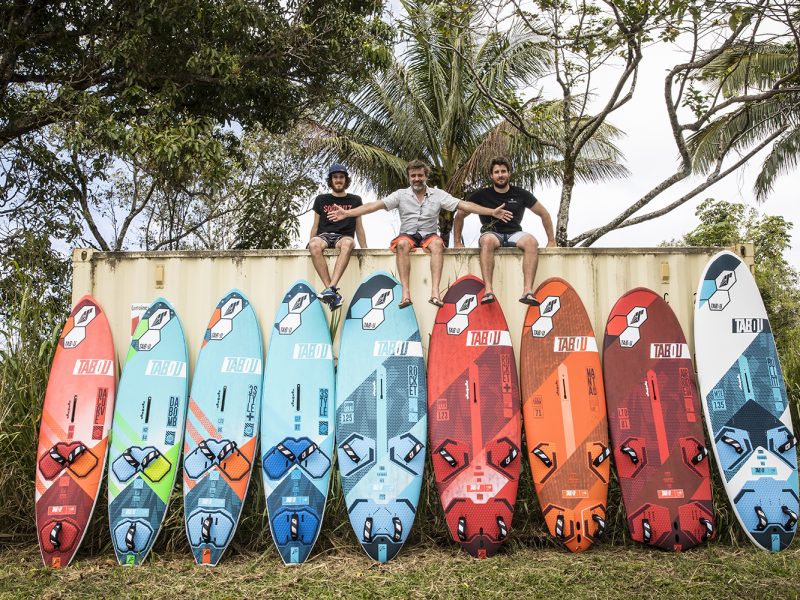
Fabien Vollenweider is one of windsurfing’s most respected shapers. As the man behind Tabou’s board designs he is known for his high performance shapes, but did you know he designed the BIC Techno and has been shaping since he was 14 years old. Fabien gives us a revealing insight into his work.
Photos – John Carter
EARLY DAYS
I started shaping when I was 14 years old! At that time you could buy a shaping kit in the shop with a blank, the resin and all the elements you need to make your own board. That was way back in 1980 after I started windsurfing in 1979. This was in Nice in France, after that I started working in a shaper’s shop, fixing boards, laminating, sanding and shaping some surfboards.
I came to Maui in the late eighties and I met Jimmy Lewis. He let me use his workshop and I started making boards in Hawaii. I learned a lot from watching how he worked. I decided when I came back home that I would make my own shaping factory in France. That was when Tabou started in March 1990. So it will be thirty years next year I have had Tabou Boards. I also was doing a lot of shaping for BIC for ten years. I designed the BIC Techno, which was a very popular board in its day! It was one of the biggest selling windsurfing boards ever made I think, aside from the original windsurfer back in the day.
TYPICAL DAY
I have a lot of emails to deal with from Cobra to follow up with the production in Thailand. (Editor’s note – Cobra is a Thailand based composites manufacturer with its core business in the watersports market, making boards for a lot of the major brands). I design my board on the computer and when I am happy with a shape I send the file to the factory. A month later I go over there and do the fine shaping, when they are finished I bring them back for testing. I am usually there for about two weeks. I go many times a year, maybe eight to ten trips. I bring back between 10 and 20 boards. The range has about 45 models with all the different sizes in each category and we change about one third of the shapes every year. It is impossible to change every model every year. It would not even make sense.
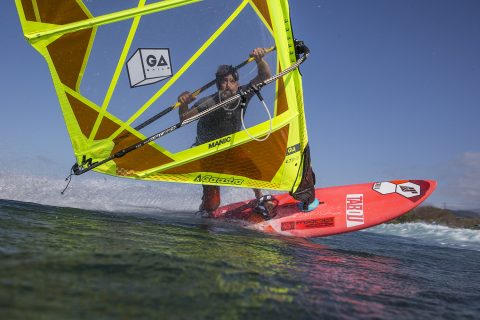
TECHNOLOGY
The technology being used today is basically the same as the last twenty years. We change a few small details, but the main technology has stayed the same. The boards are all made in Cobra and I have my little office and shaping room over there. That is it and it is segregated from the other brands’ areas. I am not allowed to walk around. In the past, fifteen years ago, we could move around in the factory, but there were some issues, so now we are kept to our own areas.
PASSION
I love to windsurf. I sail a lot and that is a big part of what keeps me passionate. I like receiving feedback from the guys and it is always nice when you have positive feedback from a board. That always makes me feel motivated when I meet happy customers on the beach that have enjoyed my products. I am a wave sailor so that is my main passion. I don’t really sail too much freeride or slalom equipment, except when I need to test something. But for pleasure I love to sail in the waves.
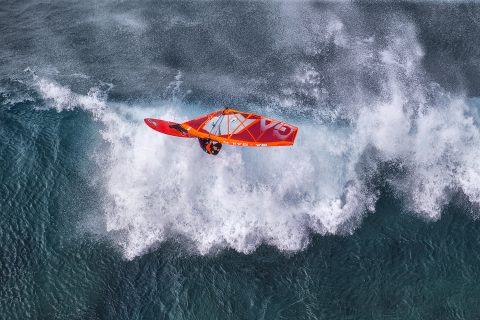
TRAVERSA
Thomas uses very different boards to any other riders. His own boards are made for him and they are very special. He likes to sail with so much tail kick; there are not many riders that can sail with this style of board. The tail kick helps him to throw the board around the turns because he does not have so much physical power as the heavier guys. A few years ago we made some boards that had a similar rocker line to Thomas’s boards and the magazine tests just killed us. His boards work for him and they are very unique.
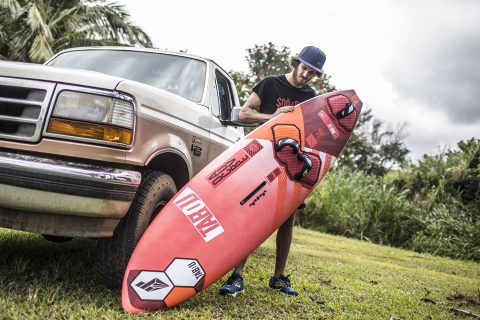
THE GOAL
We are looking for sailors at every level to be happy with our wave boards. We use a lot of feedback from our riders, but at the end of the day the boards need to work for everybody. With the slalom and foil boards I am relying on the feedback from our riders. I don’t have my own personal feedback as I don’t sail these models so much. The process is all the same for the race boards. We keep sending files, receive prototypes and test until all the testers are happy with the final product. We do a lot of modifications at home in Marseille in my workshop. I can change rocker lines and many other aspects of the boards at home so we can be back on the water as fast as possible. With slalom boards we are also making boards that will work for the full team. Ross Williams, Sebastian Koerdel and Cedric Bordes all have to compete, we cannot design the boards for just one guy. All the different national riders have to use the production boards so that is why making a board that suits everyone is very important. In the past I was working with guys like Robert Teriitehau and Fabien Pendle making boards only for them. Even those two guys were going in totally different directions.
TRENDS
The wave boards went shorter for a while, it’s a long trend that is moving slowly. We are moving in our own direction, I don’t like to look too much at what the others are doing. Our tails have been made shorter and we have worked a lot on the concaves.
In slalom the differences are very small across all the slalom boards, so Cederic tests our boards against other models. The differences really are so small. We have worked hard on the development of our slalom boards over the last ten years. We have come to a point where the evolution is very small at the moment. Foil is the area that will have the big advances right now, but for slalom I think we have a very good board.
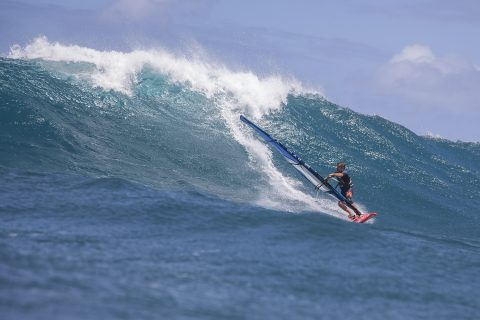
FOILS
In the beginning I almost felt like the board didn’t really matter because only the foil is in the water, but in fact after testing, it was found the board matters a lot! To go upwind on the foil you need to have a lot of leverage, so there are a lot of areas to work on. Obviously this is another board where I am relying on the feedback from our riders; I will have to start foiling!
The worst part about my job is back in the day when I was starting out I had to make a lot of custom boards in order to have enough money to live. I was almost doing a full production business and making boards over and over again. That era was less interesting for me until the machines came into play. With the CNC machines, once you have a good shape you just press a button and you have a replica of that shape. Most of my work nowadays is on the computer for all my designing. I use engineering programs; most guys use the program ‘Shape3d’, but I use a program that can design pretty much anything. It took a long time to learn, but after you have mastered it you have no limits. You can design anything, so I can design parts, inserts, whatever I want.
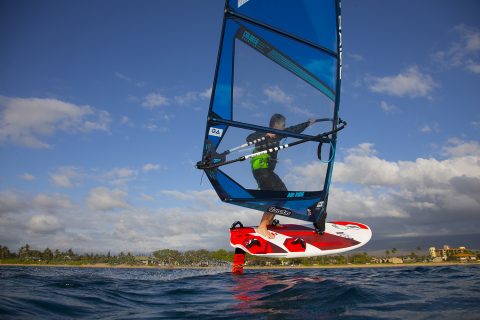
COSTS
There are a lot of factors involved in the rising costs of windsurfing boards. People want better boards but the materials are becoming more expensive. The market has reduced in size, so the quantity of the materials we buy is becoming smaller and smaller and thus we can’t get the same deals as we do with bigger product runs. Everybody wants carbon and the strongest and lightest boards. Normally you share the cost of a mould by the number of boards you are making, so if you are producing less, than the costs are more expensive per board. The labour costs in Asia also went up a lot which has not helped either. People also want more boards in a line, so we have to make quite close increments in sizes. All these factors have combined to make the price go up.
I feel we have already passed the limit where boards are too expensive. But what I see is a huge second hand market. The boards are crazy strong if you compare them to surfboards. A three year old board can be in very good shape and they are very inexpensive to buy. For us it is a problem, but for the sport it is a great thing. A board that cost €2500 new can cost €800 after one year. Even so, we normally sell our premium construction models the most, people want the quality.
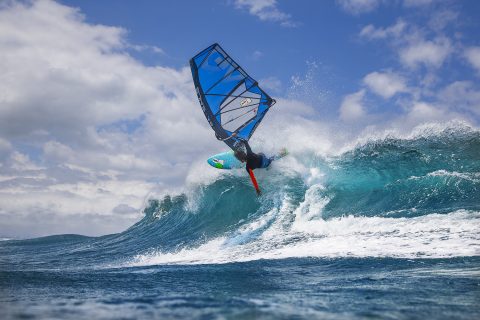
AMBITIONS
The thing that is most important to me is for my customers to be happy. That is what drives me always. I bought a planer off of Jimmy Lewis back in the early days and I always remember him saying, “I hope this tool will bring you the smile of customers that are happy with your boards!” I agree with this. I love to hear people telling me they love their board and that they had a great time on it! That makes me happy to stay in my job. Titles are also nice, like when Thomas was world champion and Ross won the Formula world title. That is also satisfying. I would love to have the slalom title also, but I am not after it so much.
The post FABIEN SHAPES: FABIEN VOLLENWEIDER appeared first on Windsurf Magazine.
Windsurf Magazine https://ift.tt/2XS2YMj